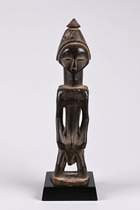Figure magique janiforme "kabeja" · R. D. Congo, Luba / Hemba · ID: 3049691
Marc Leo Felix, Brussels, Belgium
Jack & Constance Wallinga Collection, Minneapolis, USA
Bonhams, New York, 12 May 2012, Lot 245
Jack and “Connie” Wallinga collected African and Oceanic art for over sixty years. On many trips to Africa and Papua New Guinea they acquired new objects and so their collection grew to become one of the most important in the Midwest. Museums to which pieces were loaned include: Minnneapolis Institute of Art, Brooklyn Museum, New York Museum of Primitive Art, Art Institute of Chicago etc.
Description
wood, pigments, collection numbers “FX93741” and “W64” handwritten in white paint, base
In his standard work “La Grande Statuaire Hemba du Zaire”, François Neyt notes: “Whether administering justice (“kihona”), making an offering to the ancestor (“lusingiti”) …, these janus “kabeja” were always present” (Neyt, 1977, p. 483).
The “kabeja” is the fundamental object of the Hemba cult, including the cult of ancestors. In each village there is only one figure, which is in the possession of the clan chief. “Kabeja” are feared objects who were kept away from children and women and presided over all ritual acts.
Janus figures “kabeja” always represent a male and a female figure, joined back-to-back, and sharing a single cavity on top of their heads for insertion of magical mass.
They are seen as visual icon of the primordial couple, the founders of the society (“abeja” = woman, “makua” = man).
L’objet Figure magique janiforme “kabeja” numéro d’objet 3049691, a fait partie de la dernière 101e vente aux enchères du 11 novembre 2023 le Zemanek-Münster Hôtel des ventes. L’objet portant le numéro de lot 303 a atteint un prix de vente de 2 000 €.
Vous trouverez d’autres Figures et autres types d’objets populaires sur nos pages thématiques associées. Notre page sur le thème Art africain pourrait également vous intéresser.
Littérature comparée
Neyt, François, La Grande Statuaire Hemba du Zaire, Louvain-la-Neuve 1977
Publications
AHDRC: 0135564






